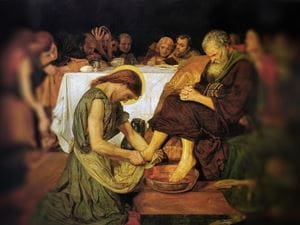
Many Christians have partaken in some type of foot-washing ceremony, and it is most widely known to be held as a feature of the Maundy Thursday service. It exists in all major churches, practicing in eastern Orthodox churches, Anglican churches, Roman Catholic churches, and all major Protestant denominations. It is a ritual of humility that helps to cleanse Christians that are affected by living in a world of sin.
Where did it come from?
In the gospel of John, there is a story of Jesus washing each of His disciple’s feet at the Last Supper. John 13:1–17 mentions Jesus performing this act. Specifically, in verses 13:14–17, He instructs them:
14 “If I then, your Lord and Teacher, have washed your feet, you also ought to wash one another’s feet. 15 For I have given you an example, that you should do as I have done to you. 16 Most assuredly, I say to you, a servant is not greater than his master; nor is he who is sent greater than he who sent him. 17 If you know these things, blessed are you if you do them.”
Following the customs of the time, it was not necessary for Jesus to clean the disciple’s feet because they would have already been washed by a servant when they entered the Upper Room. Jesus’ choice to wash the feet was to make a point about humble service towards others.
This was a strange time for the disciples because they had been arguing over who was the greatest one among them while waiting for Jesus’ arrival. Instead of tending to each other, they were comparing and competing. When Jesus stepped in to wash their feet, all the disciples were stunned into silence. Peter was profoundly against the Lord washing his feet, to which Jesus responded “unless I wash you, you have no part with me” (John 13:8). This allowed Peter to be accepting of Jesus’ humility and love.
What is a ceremony like?
All churches perform this ritual differently, but the purpose is still the same. While most hold the service on Maundy Thursday, others can hold the service once a month or even more. Take a look at your church and see what types of rituals and ceremony’s they offer surrounding food-washing.
A pastor will fill a large pitcher with warm water and place it along with a large bowl and towel at the head of the room. A normal worship service is usually conducted up until Communion begins. Those who are having their feet washed will come forward during the ceremony. During this time someone may read scriptures, such as John 13:1-11, or will offer up a prayer. Communion follows the ceremony.
At the Last Supper, Jesus washed the disciple’ feet, however the disciples did not wash each other’s feet nor did anyone wash Jesus’ feet. Because of this, many pastors choose to wash the feet of the members of the congregation but do not have their feet washed.
However, there are also some congregations have a tradition of a foot-washing service in which everyone washes everyone else’s feet. With this tradition, men and women are typically separated into two separate large rooms away from the main chapel.
Some weddings will even hold a foot-washing service for the bride and groom to show each other honor and humility. Christians do not need to wait until Maundy Thursday to find a place to hold the ritual. These rituals can be incorporated into almost any occasion.
Do we have to wash the feet of others?
No! Many Christians like to show their humility and love in other ways that do not require the literal washing of feet. Some churches will promote this to help strengthen the bond within their congregation. Other ways you can symbolically wash the feet of those you want to be of service to include:
- Engage in a random act of kindness
- Leave flowers on a friend’s doorstep
- Call someone just to check in on how they are doing
- Share words of love and appreciation
- Make amends for something you have done that may have been hurtful
- Stand up for those who are unable to do so for themselves
- Support someone, despite if you agree with their choices
- Lend a listening ear to someone going through tough times
- Bring a new person to your church
- Use your God-given gifts in new ways
The main purpose of foot-washing is caring for others, cleansing us in a sin-cursed world, and to emulate Jesus in everything we do. As long as there are genuine emotions behind the act, the service to others will bring feelings of humility and empathy. It is a beneficial act for both parties.
How do I receive service?
Take a moment and think… will you allow others to be a service to you as well? This component for many can be more challenging than caring for others. However, it is a reminder from the other person about how much they love and care for you as well.
The bible reminds us that we are loved unconditionally and are worthy of being alive. At times, we may feel the complete opposite and hold ourselves back from being offered kindness and being tended to. However it is a great moment for both parties to be reminded of unpretentiousness and love.
For many caregivers, it can be hard to remember to focus on their own health and wellbeing. If you know someone like this, or if you are a caregiver, these small acts of love and kindness can benefit you.
Have you ever been involved in a foot-washing ceremony? If so, take a few moments to reflect on that time and how you felt afterwards. Share these feelings with a trusted friend and make more of an effort to serve others in your daily life. Living and acting as Jesus did will not only make your spirit full, but also help you to be grateful.

